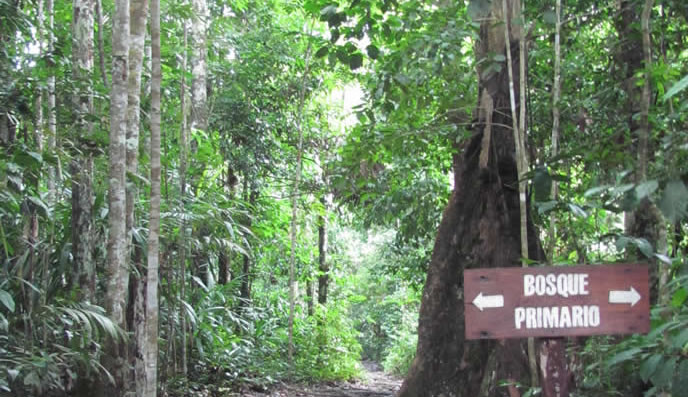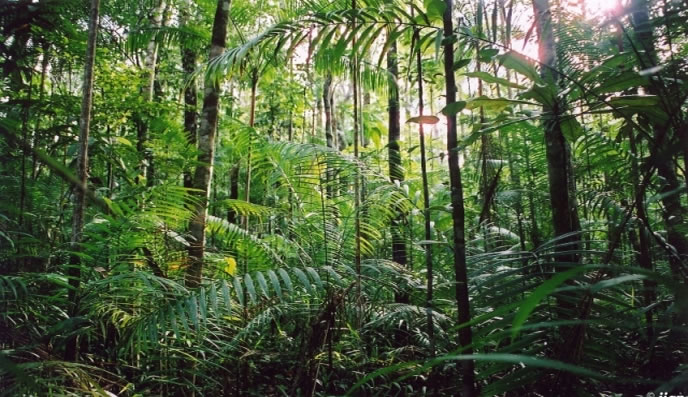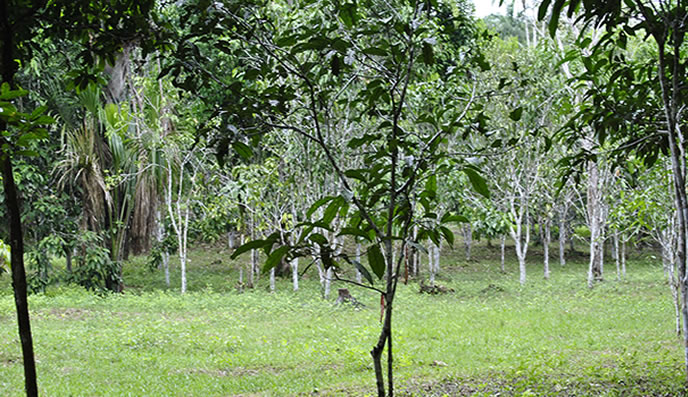
Primary Forest
this forest where natural ecosystem conditions are maintained with minimal or no human activity (logging, agriculture, etc.). Locally these forests are called center or height.
Allpahuayo Mishana National Reserve
 The biological Station "José Álvarez Alonso",belonging to the Research Institute of the Peruvian Amazon, it is an ideal place to develop research on biodiversity and neotropical evolution processes, in terra firme ecosystems, among which forests of white sand. Various national and international institutions developing their investigations, field courses in taxonomy, ecology, entomology, ornithology, herpetology, mammalogy, monitoring and surveillance of protected natural areas. It is also suitable for conservation activities, environmental education, nature tourism, hiking, bird watching, among others.
The biological Station "José Álvarez Alonso",belonging to the Research Institute of the Peruvian Amazon, it is an ideal place to develop research on biodiversity and neotropical evolution processes, in terra firme ecosystems, among which forests of white sand. Various national and international institutions developing their investigations, field courses in taxonomy, ecology, entomology, ornithology, herpetology, mammalogy, monitoring and surveillance of protected natural areas. It is also suitable for conservation activities, environmental education, nature tourism, hiking, bird watching, among others.
 It is located within the Allpahuayo Mishana National Reserve. It has an area of 2,750 hectares, with a variety of ecosystems among which forests on white sand (wet-sand, dry-sand and sagebrush) considered one of the most fragile ecosystems of the Peruvian Amazon; these ecosystems have a special wildlife with the conditions of extreme poverty of nutrients in soils. From the station you have access to floodplain forest ecosystems by sewage from the basin of the Nanay River (Igapó).
Hydrology of the Nanay River, similar to the Amazon River, with two distinct periods; the high water, "creciente" with its peak in May and low water, "vaciante", with its peak in September; the difference in water levels between the two that is six meters, on average, for the lower basin of the river.
It is located within the Allpahuayo Mishana National Reserve. It has an area of 2,750 hectares, with a variety of ecosystems among which forests on white sand (wet-sand, dry-sand and sagebrush) considered one of the most fragile ecosystems of the Peruvian Amazon; these ecosystems have a special wildlife with the conditions of extreme poverty of nutrients in soils. From the station you have access to floodplain forest ecosystems by sewage from the basin of the Nanay River (Igapó).
Hydrology of the Nanay River, similar to the Amazon River, with two distinct periods; the high water, "creciente" with its peak in May and low water, "vaciante", with its peak in September; the difference in water levels between the two that is six meters, on average, for the lower basin of the river.
 Iquitos region is known for the diversity of habitats and biodiversity records registered in its forests. Nanay basin is located in the "Ecorregion Napo", one of the richest biodiversity ecoregions. En una hectárea de bosque Allpahuayo Mishana Nacional puede ser de hasta 311 especies de árboles mayores de 10 cm de diámetro. (Gentry 1988, Vásquez-Martínez & Phillips 2000).This high diversity is a reflection of the variety of habitats (high soil heterogeneity) can be found; from forests on well-drained clay soils, to forests on white sand soils ("varillales") very poor in nutrients.
Iquitos region is known for the diversity of habitats and biodiversity records registered in its forests. Nanay basin is located in the "Ecorregion Napo", one of the richest biodiversity ecoregions. En una hectárea de bosque Allpahuayo Mishana Nacional puede ser de hasta 311 especies de árboles mayores de 10 cm de diámetro. (Gentry 1988, Vásquez-Martínez & Phillips 2000).This high diversity is a reflection of the variety of habitats (high soil heterogeneity) can be found; from forests on well-drained clay soils, to forests on white sand soils ("varillales") very poor in nutrients.
 Among the most common species of varillales are: Aspidosperma excelsum (Apocynaceae), Macrolobium limbatum (Fabaceae), Micropholis egensis (Sapotaceae), Anthodiscus pilosus (Caryocaraceae), Podocarpus celatus (Podocarpaceae), Caraipa utilis (Clusiaceae), Caraipa tereticaulis (Clusiaceae), Pachira brevipes (Bombacaceae), Pagamea coriácea (Rubiaceae), Lissocarpa kating (Lissocarpaceae), Epistiphium parviflorum (Orchidaceae), Mauritia carana (Arecaceae), Euterpe catinga (Arecaceae), Dicymbe uaiparuensis (Fabaceae), Metteniussa tessmanninana (Icacinaceae), Sterigmapetalum obovatum (Rhizophoraceae), Humiria balsamífera (Humiriaceae) and Doliocarpus dentatus (Dilleniaceae). In the herbaceous layer are several species of ferns Trichomanes spp., Elaphoglossum pilosum, Lindsaea sp., Metaxya lanosa and melastomatáceas as Granfenrieda limbata.
Among the most common species of varillales are: Aspidosperma excelsum (Apocynaceae), Macrolobium limbatum (Fabaceae), Micropholis egensis (Sapotaceae), Anthodiscus pilosus (Caryocaraceae), Podocarpus celatus (Podocarpaceae), Caraipa utilis (Clusiaceae), Caraipa tereticaulis (Clusiaceae), Pachira brevipes (Bombacaceae), Pagamea coriácea (Rubiaceae), Lissocarpa kating (Lissocarpaceae), Epistiphium parviflorum (Orchidaceae), Mauritia carana (Arecaceae), Euterpe catinga (Arecaceae), Dicymbe uaiparuensis (Fabaceae), Metteniussa tessmanninana (Icacinaceae), Sterigmapetalum obovatum (Rhizophoraceae), Humiria balsamífera (Humiriaceae) and Doliocarpus dentatus (Dilleniaceae). In the herbaceous layer are several species of ferns Trichomanes spp., Elaphoglossum pilosum, Lindsaea sp., Metaxya lanosa and melastomatáceas as Granfenrieda limbata.
Floodplain forests of the Nanay River, locally known as "tahuampa sewage" share characteristics and species forests with "igapo" the Black River in Brazil, including genera of plants, asSymmeria sp. and Mollia sp. y especies como Caryocar microcarpum, entre otras plantas especialistas de este tipo de bosque, [(Prance, 1980, Encarnación, 1993; Gentry y Ortiz 1993; IIAP 2000)
In the area of the reserve there are at least 145 species of mammals in 16 species of marsupials, 9 species of edentates, 63 species of bats, 13 species of primates, 10 species of carnivores, 2 species of dolphins, 5 species of ungulates and 27 species of rodents. Approximately 28 species are categorized as vulnerable, among which mono tocon Callicebus lucifer, tocon negro Callicebus torquatus, tamandúa Myrmecophaga tridactyla, armadillo gigante Priodontes maximus; otorongo Pantera onca, species near threatened status. Among the species categorized as rare highlights Procyon cancrivorus and Paleosuchus palpebrosus. Twenty species of birds are associated with white sand forests on the area, and several of them, these forests near Iquitos is the only known range in Peru .; as perlita de Iquitos, Polioptila clementsi, critically endangered species. At least six new bird species have been discovered in the last five years Allpahuayo Mishana, four of which have recently been described.
| Location | District: San Juan Bautista, Province: Maynas, Department: Loreto |
| Distances | Iquitos – Centro de Investigación Allpahuayo = 26.5 km |
| Time distance | 20 a 30 minutes by car from Iquitos Airport |
| Grid Reference | LO: 73°24'36'' LS: 03°51'12" |
| Area | 2750 ha |
| Altitude | 123 msnm |
| Pluviosity | Entre 2500 y 3000 mm/anuales |
| Temperatures | T° media anual: 26.9 C° |
| Seasonality | Rainy season: December – March, Dry season: April - November |
 the biological station has adequate facilities for researchers to develop their research goals more efficiently and visitors in general have a unique experience with forest; taking into account, respect and friendly attitude towards the environment that ensures the area conservation . We have suitable environments for your stay to be pleasant, superb conditions for the development of their research. We have:
the biological station has adequate facilities for researchers to develop their research goals more efficiently and visitors in general have a unique experience with forest; taking into account, respect and friendly attitude towards the environment that ensures the area conservation . We have suitable environments for your stay to be pleasant, superb conditions for the development of their research. We have:

the biological station is located in the Allpahuayo Mishana National Reserve, District: San Juan Bautista, Province: Maynas, Department: Loreto-Perú
The research center is located a short distance from Iquitos City, and is favorable place to develop multiple activities in the area of research. next are detailed the different resources and areas, are there in the Research Centre Allpahuayo to availability of researchers, students and the general public :
The Garden of Medicinal Plants was established in 1992 to maintain and preserve a living collection of Amazonian medicinal species under cultivation (ex situ) and in natural forest, serving to conduct research, develop and transfer technologies of cultivation and use.In this training garden , education and tourism are performed, as well as research papers, theses studies and pre-professional practices of national and foreign students.
This area protects a distinct ecosystems of unique combination and age, of the lower basin of Nanay river and home to an exceptional biological wealth, since it is located in the "Ecorregion Napo", one of the most biodiverse areas in the Amazon and the world. Although the highlight of Allpahuayo Mishana are their rare and antique white sand forests, Here you can find recent floodplain forests by the Nanay River (which also has numerous lakes and streams sewage, with typical flora and fauna), swamp forests, and clay hills forests, of various types, each of which has its typical community of plants and animals.

this forest where natural ecosystem conditions are maintained with minimal or no human activity (logging, agriculture, etc.). Locally these forests are called center or height.

It grows on white sandy soils are known locally varillales. They are very special and fragile ecosystems that have high soil heterogeneity and different drainage conditions, which has given rise to a unique flora and fauna adapted to very poor environmental conditions.

Forest with pioneer species that grow after the crops have been abandoned, after the original vegetation has been cleared and has been replaced by herbaceous vegetation, then scrubs, and later trees, heliofita pioneer species. As time passes the soil and microclimate conditions are changing, and primary forest species in the composition of vegetation, state which is called transitional forest.
Given the different characteristics of the groups who visit us (locals, Peruvians in general, foreign, domestic and foreign researchers, college, university, research assistants, etc., rates differ in each case.
| DESCRIPTION | COST S/. | ||
|---|---|---|---|
| Auditorium rent C.I. Allpahuayo. | S/. 58.30 | ||
| Dining room rent (includes kitchenware). | S/. 23.30 | ||
| LODGING | |||
| 1.Students in general. | S/. 5.80 | ||
| 2.Foreign Students. | S/. 17.50 | ||
| 3.National professionals. | S/. 17.50 | ||
| 4.Foreign professionals. | S/. 35.00 | ||
| 5.General Public. | S/. 35.00 | ||
| INGRESO AL C.I. ALLPAHUAYO:LOCALES | |||
| a)Public Educational Institutions | |||
| 1.Students, Primary, Secondary Level. | S/. 0.58 | ||
| 2.Universities or Superior Inst. | S/. 1.17 | ||
| ENTRY C.I. ALLPAHUAYO: NATIONAL | |||
| a) Public Educational Institutions | 1.Initial, Primary, Secondary Students. | S/. 1.17 | |
| 2.Universities or Superior Inst. | S/. 3.50 | ||
| b) Individuals: people | |||
| 1.Over 15 years old. | S/. 9.30 | ||
| 2.Children under 14 years of age | S/. 5.80 | ||
| ENTRY C.I. ALLPAHUAYO: FOREIGNERS: | |||
| 1.Students. | S/. 17.50 | ||
| 2.Visitors. | S/. 23.30 | ||
In addition, the researcher interested should send their research proposal clearly and summary, which will be evaluated prior to approval. It is important that you notify the date of their arrival in at least one month in advance.
The Research Institute of the Peruvian Amazon has an internship program that provides an opportunity for young students or recent graduates, from around the country and around the world, to meet and work at the Allpahuayo Research Center, mechanisms for protection and promotion offered by the Inter-American System of Human Rights. One benefit of this program is to further the knowledge gained during the internship is applied in the country of origin of the intern.
the biological station has opportunities for young students of Biology, Ecology, graduates,and related careers., during the internship, participants have the opportunity to work alongside professionals and officials of IIAP in different activities developed by the biological station. The internships are unpaid.
Those interested should download all the documents with the requirements for acceptance into the biological station.
If you have any questions or precise to know more about the biological station "José Álvarez Alonso", please Email Us.